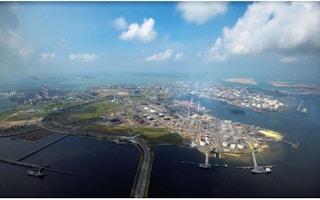Ownership and a pervasive culture of sustainability are critically important in pursuing energy efficiency at the corporate level, said experts at a recent online dialogue organised by Accenture.
To continue reading, subscribe to Eco‑Business.
There's something for everyone. We offer a range of subscription plans.
- Access our stories and receive our Insights Weekly newsletter with the free EB Member plan.
- Unlock unlimited access to our content and archive with EB Circle.
- Publish your content with EB Premium.
The idea is to think of the CEO as the chief energy officer, said Juan Aguiriano, president for Asia-Pacific DuPont Sustainable Solutions of DuPont in Singapore, and one of the speakers at the event.
Called Sustainability 24, the one-day digital conference focused on the theme of “Sustainability Innovation: Scaling for Transformational Impact”.
The annual event by the international management consulting firm pushes for business sustainability in the global agenda by convening various leaders from business, government and the academia in different thematic sessions in different cities worldwide.
Talks started in Beijing and ended in San Francisco in a 12-hour duration.
In Singapore, the third out of 11 locations, the theme was “Total Energy Management: Transformation for Enterprise Energy Efficiency”.
The country has recently put its new Energy Conservation Act (ECA) into force, and this primarily requires energy-intensive companies, or those whose energy consumption is more than 54 terajoules (TJ) per year, to designate an energy manager, monitor and report energy use and greenhouse gas emissions, and submit energy efficiency improvement plans.
“
CEO now means ‘chief energy officer’
Juan Aguiriano
Singapore, according to the report released by Accenture at the talk, is “in an effort to improve (its) energy efficiency and competitiveness.”
Andrew Tan, one of the presenters and chief executive officer of the National Environment Agency, noted that Singapore is an energy-disadvantaged country to begin with, importing most of its energy from abroad.
However, it was only in the past decade or so that it has given energy more priority, taking an integrated approach to achieve greater energy efficiency, he said.
Julian Ho, assistant managing director of the Singapore Economic Development Board (EDB), who also spoke at the event, added that the country is essentially an “urban city with a need to optimise resources that are very scarce.”
But, Ho said, this is an opportunity to make Singapore a “living laboratory” on energy management and create solutions that Singapore can export.
Currently, 21 per cent of Singapore’s economic output comes from manufacturing, which is an energy-intensive sector, he described. “To be globally competitive, they need to be energy efficient.”
The pressing question is how to. To this end, Accenture’s report, produced in partnership with the NEA, assessed the state of energy management maturity of 100 companies in Singapore in the report “Driving Energy Management Transformation”.
The report found that companies can generally improve people-centric and performance management related areas of energy management.
“Improving on these ‘softer’ elements will enable companies to realise and sustain the full benefits of energy management,” said the report.
Ho added: “Pervasive sustainability, not just in technology; but, in culture, mindset and partnerships within the industry” are what it takes for a company to be energy efficient.
DuPont, one of the world’s diversified companies, is an embodiment of this practice. Aguiriano, who has advised organisations on reducing environmental footprint and increasing producitivity in his position at DuPont, shared the firm’s many examples of embedding energy efficiency in the business.
“It is a very strategic component that is critical to the success of the corporation,” he said. DuPont has saved $6 billion due to energy efficiency. But he added that profit is not the sole component of importance, it is also the reduction of their greenhouse gas emissions, driven by proper management of energy use. This is in line with the triple bottom line, he said, referring to ‘people, planet and profit’ which measures success based on economic, ecological, and social factors.
Every leader in the company must be knowledgeable, he said. “There is no energy department.” Energy use and its efficiency should be in everyone’s same metric card, he explained.
Interestingly, in DuPont, energy management programmes are not driven by capital, shared Aguiriano. Instead, it is driven “by a thousand projects with little operating expenses.” The initiatives come from employees and not engineers, creating a grassroots, bottoms up approach, he said.
Similarly, Tan said that in the public sector they first look at the low hanging fruit to optimise energy efficiency. Adjusting indoor lighting and ventilation are some examples of these doable actions he enumerated.
For Ho, “These things are fundamentals … It’s really giving people no excuse.”
To inspire ownership and demonstrate leadership, companies should find other firms with best practices. He cited a company in Jurong Island which serves other companies in the island by turning waste into energy.
Sembcorp Industries, a global energy, water and marine business, opened a waste-to-energy plant last year, and it uses recovered woodchip to produce processed steam. This is on top off an industrial wastewater treatment facility they also opened in the island.
Ernst Worrell, professor of ‘energy, resources & technological change’ at Utrecht University and another panellist at the talk, likened the search for energy efficiency prospects and examples to a treasure hunt. Companies must “scavenge for opportunities.”
“There are millions of opportunities. Energy is invisible. You have to chase it,” Aguiriano said.
However, Ynse de Boer, Accenture managing director for management consulting, strategy and sustainability in ASEAN, who moderated the discussion and authored the report, underscored a vital issue.
Surveyed companies showed uncertainty and low energy management maturity, so he emphasised that there has to be a “coalition of the willing to break inertia.”










